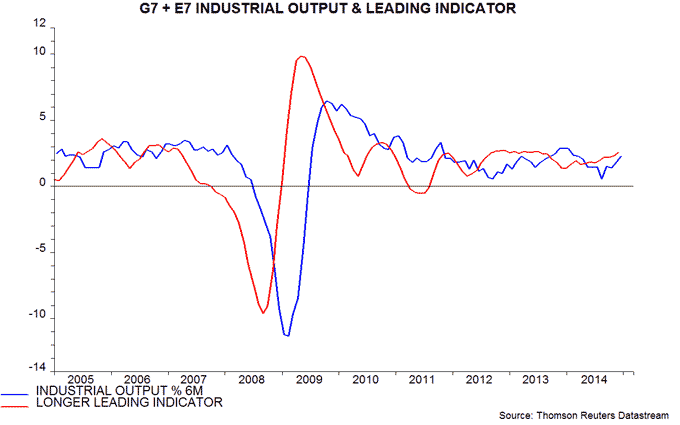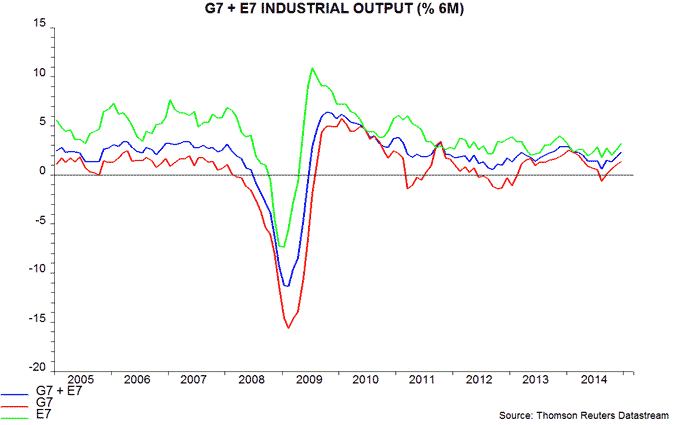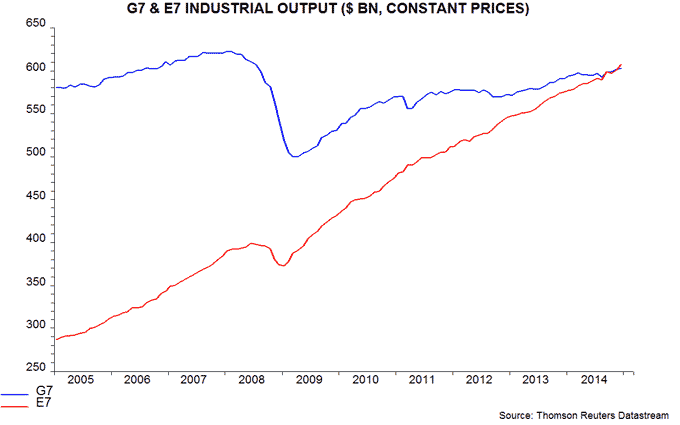Entries from February 1, 2015 - February 28, 2015
Japanese money / wage trends signalling stronger economy
Japanese monetary trends remain strong, suggesting upside risk to the consensus forecast of 1.2% GDP growth in 2015.
The six-month change in M1, M2 and M3 peaked in late 2013 and fell sharply through July 2014. The real-terms change turned negative from April, when a rise in the sales tax from 5% to 8% boosted consumer prices by 2.1%*. This contraction was reflected in falls in GDP in the second and third quarters – see first chart.
Money measures, however, have rebounded strongly since July, while the sales tax hike dropped out of the six-month inflation rate in October. Six-month real money growth, therefore, is back at levels consistent with solid economic expansion. Industrial output rose by 1.7% between the third and fourth quarters while next week’s GDP release may report an increase of about 1%, or 4% annualised.
Also notable is a continued firming of wage trends, consistent with evidence of a tight labour market. Total cash earnings at firms with 30 or more employees rose by an annual 2.5% in December, reflecting a 3.4% increase in winter bonuses. More significantly, growth in scheduled earnings (i.e. excluding bonuses and overtime) climbed to 1.2%, a level matched or exceeded in only three months since 1997. With headline consumer price inflation on course to fall to zero in the spring as a result of oil and tax effects, annual real wage growth should soon be running at 1-2% – second chart.
*Bank of Japan estimate.
E7 industrial output above G7, reflecting China
The global economy is dominated by the G7 countries and the seven largest emerging economies, or “E7”*. Six-month growth of industrial output in these fourteen economies rose to an estimated 2.3%, or 4.7% annualised, in December**. The longer leading indicator calculated here suggests that the recent upswing will extend through the first half of 2015, at least – see first chart.
The recovery in G7 plus E7 growth from a low in August 2014 reflects stronger expansion in both groups. Growth remains significantly higher in the E7 than G7, although the current gap is below its average since 2010 – second chart.
The G7 and E7 aggregates are calculated from World Bank country data on industrial output in constant (2005) US dollars. On this measurement, E7 industrial output now exceeds the G7 level. The ratio of E7 to G7 output has risen from 49% at the start of 2005 to 100% in September 2014 and 101% by December – third chart.
E7 / G7 convergence reflects enormous growth of industrial output in China. China now accounts for 62% of E7 output and 31% of the G7 plus E7 aggregate. The latter compares with 22% for the US. On the World Bank figures, Chinese industrial output surpassed the US level as long ago as 2009. Chinese output has risen by a cumulative 228% since January 2005 versus 34% for the rest of the E7 and only 4% for the G7.
*BRIC plus Korea, Indonesia and Mexico. The G7 plus E7 countries account for three-quarters of global industrial output, according to World Bank data.
**80% data coverage. December output is assumed to be unchanged from November for missing countries.
EM money growth still weak, significant country divergence
Emerging market equities are slightly ahead of developed markets year-to-date but relative monetary trends question whether outperformance can continue.
The first chart shows the ratio of MSCI's emerging markets index in US dollars to its developed markets index, together with the six-month rates of change of real narrow money M1 in the G7 and seven large emerging economies. Emerging markets outperformance during the 2000s occurred when E7 real money growth was higher than G7 growth or was rising strongly. The E7 / G7 gap has been mostly negative during the sustained relative bear market since 2010.
Current conditions are unpromising, with G7 real money growth higher and rising strongly but E7 growth down sharply in December.
Weakness in the E7 aggregate is due to real M1 contraction in Russia, Brazil and China, and a recent slowdown in India. By contrast, monetary trends are strong in Korea, Mexico and Taiwan – second chart.
Russian real M1 fell by 9.1%, or 17.4% annualised, in the six months to December, reflecting both nominal money contraction and a currency-driven inflation surge. The economy was temporarily supported by panic spending of rouble money balances at end-2014 but industrial output should slump in early 2015 – third chart.
Global growth pick-up / unemployment fall questions policy ease
The monetarist / leading indicators forecasting approach used here suggested that the global economy would lose momentum during the first half of 2014 but revive during the second half. This proved broadly correct, although the activity trough occurred slightly later than expected: six-month growth of global* industrial output peaked in November 2013, falling to a low in August 2014 before recovering strongly through December 2014 – see first chart.
The forecasting approach now suggests that growth will remain solid or rise further during the first half of 2015. The global longer leading indicator continued to edge higher in December, while six-month real narrow money expansion has been boosted by falling energy prices – first chart.
A striking feature of the 2014 slowdown was its limited impact on labour markets. The G7 unemployment rate trended lower through the year, reaching its lowest since 2008. Stronger recent and prospective growth implies a significant further decline, a scenario consistent with consumer surveys showing less concern about labour market conditions – second chart.
Unemployment rates are now below 25-year averages in the four largest G7 economies. The US, Japanese and UK jobless rates are at their lowest levels since 2008, 1997 and 2008 respectively, with the German rate at a record low in data extending back to 1990 – third chart.
Job openings rates – unfilled vacancies expressed as a percentage of employment plus vacancies – are an alternative gauge of labour market tightness, with above-average readings signalling that employers are finding difficulty recruiting suitable workers. Openings rates in the US, Japan and the UK are the highest since 2001, 2006 and 2008 respectively, with the German rate at a post-1990 record – fourth chart.
The final four charts show, for each economy, a measure of wages / salaries growth along with the job openings rate. Current growth is higher than in 2013 in all four cases, with the current level of the openings rate suggesting a further, possibly sizeable, increase.
Central banks, in aggregate, are in the process of easing policy significantly, partly in response to a favourable oil supply shock, despite an upswing in the economic cycle and limited labour market slack. This is likely to prove a mistake, with a reassessment necessary later in 2015.
*G7 plus seven large emerging economies.



Money trends suggesting UK / Eurozone growth convergence
UK monetary trends remain consistent with solid economic growth but are no longer stronger than in the Eurozone, suggesting that the UK’s period of outperformance is nearing an end.
The preferred narrow and broad monetary aggregates here are “non-financial” M1 and M4, covering holdings of households and private non-financial firms but excluding “other financial corporations”. M1 comprises notes / coin and sight deposits, with M4 adding in other deposits, repos and short-maturity bank paper.
Six-month growth of non-financial M1 fell further in December to 2.8%, or 5.6% annualised, the lowest since July 2012. Non-financial M4 expansion, by contrast, was stable at 2.6%, or 5.3% annualised – above its level for much of 2013 and 2014. Narrow and broad money growth, therefore, have converged – see first chart.
The slowdown in non-financial M1 is unlikely to presage economic weakness, for three reasons. First, current growth remains respectable. Secondly, the slowdown reflects lower growth of household M1; corporate M1 is still rising fast and is usually a good guide to economic prospects. Thirdly, the deceleration of non-financial M1 has been matched by a decline in consumer price momentum – first chart. Its real growth, therefore, has moved sideways since summer 2014, while that of non-financial M4 has risen sharply – second chart.
Eurozone real non-financial M1 growth was below the UK level for most of 2012-2014 but is now significantly higher – third chart. The current gap is comparable with 2010-11, when Eurozone and UK GDP rose at a similar pace (2.0% and 1.9% respectively in 2010, and 1.7% and 1.6% in 2011).

